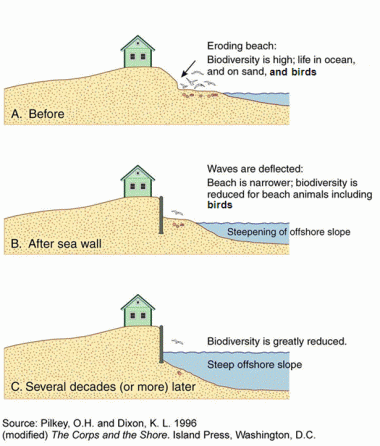Shore Protect Team for Dummies
Table of ContentsLittle Known Facts About Shore Protect Team.5 Easy Facts About Shore Protect Team ExplainedShore Protect Team - QuestionsThe 5-Minute Rule for Shore Protect TeamThe Ultimate Guide To Shore Protect TeamSome Known Details About Shore Protect Team About Shore Protect Team
Decline in residential or commercial property value: As the location tourism is influenced by disintegration, so then is the economy. Customers are much less most likely to browse for a beach residence that can be damaged at any minute by the impending flooding and disintegration emergency. In turn, building worth can go down exceptionally and impact the entire region.Whether a coastline is just tiny and congested or needs to close totally for the safety and security of the community and nearby homes, this considerably influences tourism. Consequently, neighborhood economies are impacted (https://list.ly/shrprtcttm/lists). Threat of injury: The raised danger of flooding and structural failures triggers an increased threat of injury to nearby vacationers and area members

Shoreline stabilization is directly related to their job. Waterfront hotels: Due to the fact that coastline disintegration influences tourist, it impacts the success of waterside resorts.
Not known Factual Statements About Shore Protect Team
This ultimately causes closures and abandoned beachfront residential or commercial properties. Coastal commercial businesses: No travelers implies no company. For those companies satisfying residents, their home is at risk of damages from erosion and flooding. Coastal state parks: State parks that exist along coastlines are at threat of damage. Not just to the manmade structures and homes on site, however likewise to the natural communities that exist within.
Difficult stablizing makes use of synthetic structures as protection to control erosion. Most forms of hard stabilization like seawalls and sheet metal are not suitable for coastline stabilization.
Getting The Shore Protect Team To Work
There's additionally insufficient evidence of their effectiveness relying on the kind of shoreline and local problems. Tough stabilization methods tend to be more tough to install and do not match the natural visual, protruding like an aching thumb and hurting regional ecosystems in many situations. Coastline sustenance is the process of adding shed sand and sediment back to coastlines after disintegration has occurred.
TrapBags help in the process of beach nutrition by securing all-natural environments and allowing plants to grow. They're: Ecologically friendly: You can utilize indigenous dirt both to surround and to load the TrapBags.

The Ultimate Guide To Shore Protect Team
Easy to set up: Relieve of installment means TrapBags can be released rapidly in the occasion of an emergency situation. They can also be mounted without any type of heavy equipment. Budget-friendly: TrapBags are optimal for both tiny and big locations of coastline. They provide an inexpensive remedy to cover jobs of any dimension.
The proper seawall layout counts on location-specific facets, consisting of bordering erosion procedures. There are 3 major kinds of seawalls: upright, bent, tipped, and piles (see table listed below).
All-natural barriers, such as coral reefs and mangrove woodlands, protect against the spread of tsunamis and the circulation of seaside waters and reduced the flood and surge of water. A cost-benefit method is an efficient method to figure out whether a seawall is ideal and whether the advantages deserve the cost.
See This Report about Shore Protect Team
A seawall is a fixed attribute which can contrast with the dynamic nature of the coast and impede the exchange of debris in between land and sea. The table listed below sums up some favorable and negative results of seawalls which can be made use of when comparing their effectiveness with various other coastal management choices, such as beach nourishment. [] Advantages and drawbacks of seawalls according to Short (1999) Benefits Drawbacks Long term service in contrast to soft beach nourishment.

This can create beaches to dissipate, making them worthless for beach goers. Typically, seawalls can be an effective way to regulate coastal erosion, yet just if they are built well and out of products that can endure the pressure of recurring wave energy. Some understanding is needed of the coastal processes and morphodynamics certain to the seawall area.
The Single Strategy To Use For Shore Protect Team
The appropriate seawall layout counts on location-specific facets, including bordering disintegration procedures. There are 3 primary types of seawalls: vertical, rounded, stepped, and mounds (see table listed below).
All-natural barriers, such as coral reefs and mangrove woodlands, avoid the spread of tidal waves and the circulation of coastal waters and reduced the flooding and rise of water. A cost-benefit approach is an efficient means to identify whether a seawall is appropriate and whether the benefits are worth the cost.
The 6-Second Trick For Shore Protect Team
A seawall is a static function which can contrast with the dynamic nature of the coastline and impede the exchange of debris between land and sea. The table below summarizes some positive and unfavorable results of seawalls which can be utilized when comparing their performance with various other seaside management choices, such as beach nutrition. [] Benefits and drawbacks of seawalls according to Short (1999) Advantages Disadvantages Long-term service in contrast to soft beach nutrients. lakefront stabilization.

This can create coastlines to dissipate, providing them useless for coastline goers. Normally, seawalls can be an effective means to regulate coastal disintegration, yet just if they are created well and out of products that can withstand the force of recurring wave energy.